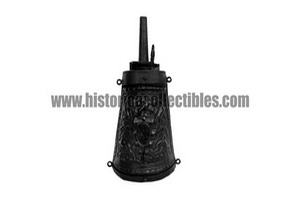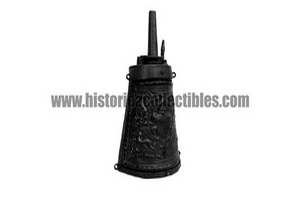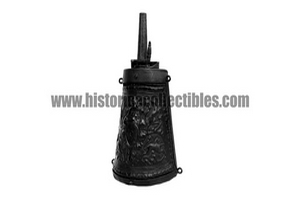Florentine Powder Flask, circa 1550
Powder Flask or flask for gunpowder, made of wood, iron and embossed, hardened and cut leather (called boiled leather) with a trapezoidal shape and a rounded front. Made around 1550 in Florence, a city which, for several centuries starting from the Middle Ages, was the most renowned and important city at the peak of production in which leather was used in all its processes. Even today the high quality standards that distinguish Italian leather and fur remain the most renowned in the world.
The Flask has a wooden body on which the artistically worked boiled leather is shaped, then hardened and cut, then an iron structure surrounding the profiles is applied to block all the parts together. The measuring spout is equipped with a spring lever for closing and opening the gunpowder passage.
These types of flasks, due to the evident ornamental artistic workmanship of the leather, were intended for the most important Florentine noble families such as the Strozzi, Medici, Pitti etc.
Excellent condition with untouched patina, completely original.
Dimensions 22cm high, 11.5cm wide at the base.
Historical notes:
The history of Florentine leather has its roots in very ancient times. Generally its origins date back to the Etruscan era, although the greatest impetus occurred in the Middle Ages.
It was precisely towards the end of the 13th century that the Arte dei Cuoiai e dei Galigai was born, a corporation that brought together all the trades involved in leather processing: leather workers, "pelacani" (tanners), "pezzai" (retailers) and "orpellai” (gilders). The association imposed extremely strict rules with very serious punishments for those who did not comply with the statute. Only in this way was it possible to guarantee the achievement of the high quality standards that still today distinguish Italian leather as the most renowned in the world.
The Arno river was crucial for the development of the tanning industry and for the production of Florentine leather: its presence in fact facilitated the transport of goods and it is precisely in its waters, upstream and downstream of Ponte Vecchio, that the skins were leave to soak for tanning.
But the actual tanning activity was concentrated in a specific area of the city, namely in the narrow streets that connected Piazza Santa Croce to Piazza della Signoria. Each alley in the area bore the name of one of the leather crafts. Some names, such as Via dei Bucciai and Via dei Pelacani, have unfortunately been replaced over time, while others, such as Via dei Conciatori and Via della Concia, still survive as evidence of the laborious production activity of the time.
References:
The Walters Art Museum - Second Floor: Arms and Armor - Accession Number 51.592
Philadelphis Museum of Art - Accession Number 1977-167-893
Philadelphis Museum of Art - Accession Number 1977-167-894
Philadelphis Museum of Art - Accession Number 1977-167-890
Victoria and Albert Museum - Accession Number 611-1893
Victoria and Albert Museum - Accession Number 2235-1855
Metropolitan Art Museum - Accession Number 14.25.1441
The Cleveland Museum of Art, Cleveland, OH - Accession Number 1918.65




